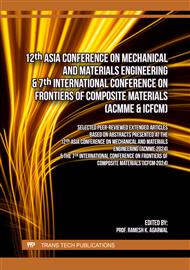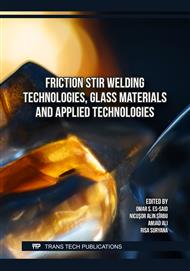[1]
Y. LeCun, Y. Bengio, and G. Hinton, "Deep learning," nature 521, 436–444 (2015).
DOI: 10.1038/nature14539
Google Scholar
[2]
A. Garcia-Garcia, S. Orts-Escolano, S. Oprea, V. Villena-Martinez, and J. Garcia-Rodriguez, "A review on deep learning techniques applied to semantic segmentation," arXiv preprint arXiv:1704.06857 (2017).
DOI: 10.1016/j.asoc.2018.05.018
Google Scholar
[3]
G. Di Leo, C. Liguori, A. Pietrosanto, and P. Sommella, "A vision system for the online quality monitoring of industrial manufacturing," Optics and Lasers in Engineering 89, 162–168 (2017).
DOI: 10.1016/j.optlaseng.2016.05.007
Google Scholar
[4]
Pastor-López, I. Santos, A. Santamaría-Ibirika, M. Salazar, J. De-la Peña-Sordo, and P. G. Bringas, "Machine-learning-based surface defect detection and categorisation in high-precision foundry," in 2012 7th IEEE Conference on Industrial Electronics and Applications (ICIEA) (IEEE, 2012) p.1359–1364.
DOI: 10.1109/iciea.2012.6360934
Google Scholar
[5]
A. M. Hafiz and G. M. Bhat, "A survey on instance segmentation: state of the art," International journal of multimedia information retrieval 9, 171–189 (2020).
DOI: 10.1007/s13735-020-00195-x
Google Scholar
[6]
S. M. Azimi, D. Britz, M. Engstler, M. Fritz, and F. Mücklich, "Advanced steel microstructural classification by deep learning methods," Scientific reports 8, 1–14 (2018).
DOI: 10.1038/s41598-018-20037-5
Google Scholar
[7]
D. Tabernik, S. Šela, J. Skvarˇc, and D. Skoˇcaj, "Segmentation-based deep learning approach for surface-defect detection," Journal of Intelligent Manufacturing 31, 759–776 (2020).
DOI: 10.1007/s10845-019-01476-x
Google Scholar
[8]
F. Silva, X. Bonnin, J. Achard, O. Brinza, A. Michau, and A. Gicquel, "Geometric modeling of homoepitaxial cvd diamond growth: I. the 100111110113 system," Journal of Crystal Growth 310, 187–203 (2008).
DOI: 10.1016/j.jcrysgro.2007.09.044
Google Scholar
[9]
I. Sunagawa, "Growth and morphology of diamond crystals under stable and metastable contitions," Journal of Crystal Growth 99, 1156–1161 (1990).
DOI: 10.1016/s0022-0248(08)80100-5
Google Scholar
[10]
Minaee, S., Boykov, Y., Porikli, F., Plaza, A., Kehtarnavaz, N., & Terzopoulos, D. (2021). Image segmentation using deep learning: A survey. IEEE transactions on pattern analysis and machine intelligence, 44(7), 3523-3542.
DOI: 10.1109/tpami.2021.3059968
Google Scholar
[11]
M. Muehle, J. Asmussen, M. Becker, and T. Schuelke, "Extending microwave plasma assisted cvd scd growth to pressures of 400 torr," Diamond and Related Materials 79, 150–163 (2017).
DOI: 10.1016/j.diamond.2017.09.013
Google Scholar
[12]
K. Konyushkova, R. Sznitman, and P. Fua, "Learning active learning from data," Advances in neural information processing systems 30 (2017).
Google Scholar
[13]
"The leading training data platform for data labeling," Labelbox.
Google Scholar
[14]
M. Desmond, M. Muller, Z. Ashktorab, C. Dugan, E. Duesterwald, K. Brimijoin, C. Finegan-Dollak, M. Brachman, A. Sharma, N. N. Joshi,et al., "Increasing the speed and accuracy of data labeling through an ai assisted interface," in 26th International Conference on Intelligent User Interfaces (2021) p.392–401.
DOI: 10.1145/3397481.3450698
Google Scholar
[15]
S. Jadon, "A survey of loss functions for semantic segmentation," in 2020 IEEE Conference on Computational Intelligence in Bioinformatics and Computational Biology (CIBCB) (IEEE, 2020) p.1–7.
DOI: 10.1109/cibcb48159.2020.9277638
Google Scholar



